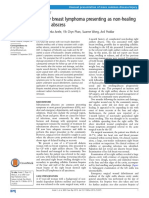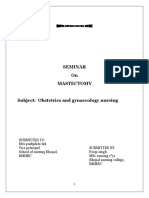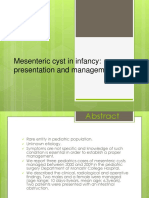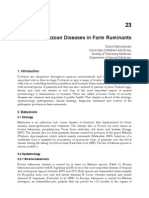Dodge Kegel - Breast Cancer An Illustrated Case Study
Dodge Kegel - Breast Cancer An Illustrated Case Study
Uploaded by
V ThrivikramCopyright:
Available Formats
Dodge Kegel - Breast Cancer An Illustrated Case Study
Dodge Kegel - Breast Cancer An Illustrated Case Study
Uploaded by
V ThrivikramOriginal Description:
Original Title
Copyright
Available Formats
Share this document
Did you find this document useful?
Is this content inappropriate?
Copyright:
Available Formats
Dodge Kegel - Breast Cancer An Illustrated Case Study
Dodge Kegel - Breast Cancer An Illustrated Case Study
Uploaded by
V ThrivikramCopyright:
Available Formats
“Breast Cancer:
An Illustrated Case Study”
DALEELA G. DODGE, M.D. AND JENNIFER L. KEGEL, M.D.
Judy Connolly (not her real name) had her first screen-
ing mammogram at the age of 46, and a spiculated
density was discovered in her medial left breast (Fig. 1).
Ms. Connolly then acknowledged she was able to
appreciate a palpable prominence in her medial breast
and a “lump” in her left axilla. An ultrasound (Fig. 2)
disclosed a highly suspicious mass that measured 15 ×
14 × 15 mm in the breast, and a left axillary mass that
measured 35 × 29 × 14 mm. Her primary care physician Figure 2: Ultrasound of the left breast reveals a solid mass at the
9 o’clock position of the left breast and an enlarged lymph node in the
referred Ms. Connolly to a surgeon who specialized left axilla.
in breast surgery. In the office, the surgeon performed
ultrasound-guided core biopsies of the tumor and the
axillary mass. Pathologic examination of both lesions the enlarged lymph node in the axilla; it also showed
revealed a Grade III infiltrating ductal carcinoma, which no satellite lesions and a normal right breast (Figs. 3-5).
was estrogen and progesterone receptor negative, and Based on Ms. Connolly’s aggressive and advanced breast
HER-2/neu positive. Ms. Connolly had a normal chest cancer, the surgeon felt she should be considered for
x-ray and bone scan, but a PET scan revealed tumor neoadjuvant chemotherapy. Ideally, the patient would
isolated to the breast and axilla. An MRI confirmed receive immediate systemic therapy, followed by an
the presence of the malignancy in the left breast and assessment of response to this therapy. If the patient then
chose breast conservation, this plan would improve her
chances and the ultimate cosmetic result.
Ms. Connolly was referred to a medical oncologist
and a radiotherapist, and her case was discussed at the
bi-monthly Breast Cancer Tumor Board. A course to
include neo-adjuvant chemotherapy followed by surgery
and postoperative radiation therapy was chosen. The
oncologist treated Ms. Connolly with Adriamycin and
Cytoxan followed by Taxol and Herceptin. She had a
dramatic clinical response with resolution of all palpable
disease. She was counseled by the surgeon and given the
options of breast conserving lumpectomy or mastectomy.
She chose mastectomy and, six months after her original
presentation, underwent a mastectomy with sentinel
lymph node biopsy. The pathology examination found
no residual carcinoma in either the breast or lymph
nodes. The patient plans to undergo breast reconstruc-
Figure 1: Screening film mammography in the mediolateral oblique
(MLO) and craniocaudad (CC) projection reveals the palpable mass
tion after completing her radiation therapy. She has
in the lower inner quadrant of the left breast. The enlarged lymph tolerated her treatments with minimal side effects and
node in the left axilla is partially imaged on the MLO view. no complications.
52 The Journal of Lancaster General Hospital • Fall 2006 • Vol. 1 – No. 2
JLGH-V1_2-Fall_2006.indd 52 8/23/06 4:21:30 PM
breast cancer
Figure 3: MRI in the axial plane shows the malignancy as an
enhancing lesion in the medial aspect of the left breast. (This is a 3D Figure 4: MRI in the sagittal plane shows the enhanced malignancy
Gradient Echo Subtracted MRI. The final image was obtained and a clip (black spot at tip of arrow) that was placed during the
by post-processing of contrast enhanced sequences, which results in previous ultrasound-guided core biopsy. (This is a Water Excitation
better delineation of abnormally enhanced lesions.) MRI, which uses a contrast enhanced sequence that shows optimal
detail of the internal architecture of the breast, and reveals how a
lesion affects the surrounding tissues.)
Figure 5: MRI in the axial plane reveals the enlarged lymph node in
the left axilla. (This is an Inversion Recovery MRI, which uses a
particular sequencing technique to detect adenopathy.)
The Journal of Lancaster General Hospital • Fall 2006 • Vol. 1 – No. 2 53
JLGH-V1_2-Fall_2006.indd 53 8/23/06 4:21:32 PM
You might also like
- Ap BioDocument34 pagesAp BiotehilashiftehNo ratings yet
- Clinical Immunology and Serology A Laboratory Perspective 3rd Edition Stevens Test BankDocument12 pagesClinical Immunology and Serology A Laboratory Perspective 3rd Edition Stevens Test Banktracybrownfmaczqejxw100% (16)
- ETAS MCQ 2015 - Derm-In-Review Volume 1Document672 pagesETAS MCQ 2015 - Derm-In-Review Volume 1Muhammad Javed Gaba100% (2)
- Allergy PresentationDocument14 pagesAllergy PresentationMujahid Ali100% (5)
- Club FootDocument46 pagesClub FootCarol Bruce100% (1)
- A Case Study: Prescriptive Exercise Intervention After Bilateral MastectomiesDocument5 pagesA Case Study: Prescriptive Exercise Intervention After Bilateral MastectomiesPaul GumbocNo ratings yet
- A Case Study: Prescriptive Exercise Intervention After Bilateral MastectomiesDocument5 pagesA Case Study: Prescriptive Exercise Intervention After Bilateral MastectomiesPaul GumbocNo ratings yet
- Khoo 2018Document2 pagesKhoo 2018Walid SasiNo ratings yet
- Simultaneous Cutaneous Melanoma and Ipsilateral Breast - 2024 - International JDocument5 pagesSimultaneous Cutaneous Melanoma and Ipsilateral Breast - 2024 - International JRonald QuezadaNo ratings yet
- Radiotherapy associated angiosarcoma in theDocument5 pagesRadiotherapy associated angiosarcoma in thetiaoyueasplNo ratings yet
- Kurtz 2016Document5 pagesKurtz 2016Stevano PattiasinaNo ratings yet
- MUCIN1Document4 pagesMUCIN1sabarinaramNo ratings yet
- Systemic Management of Relapse Wilms Tumor After Radical Nephrectomy in An Adult Female, A Case ReportDocument5 pagesSystemic Management of Relapse Wilms Tumor After Radical Nephrectomy in An Adult Female, A Case ReportAzizza JasmineNo ratings yet
- Vaginal Cancer Therapeutic DillemaDocument5 pagesVaginal Cancer Therapeutic DillemanosaNo ratings yet
- Extravasation of Epirubicin Chemotherapy From A Port-A-Cath Causing Extensive Breast Necrosis - Sequential Imaging Findings and Management of A Breast Cancer PatientDocument6 pagesExtravasation of Epirubicin Chemotherapy From A Port-A-Cath Causing Extensive Breast Necrosis - Sequential Imaging Findings and Management of A Breast Cancer Patient562rjgnf8hNo ratings yet
- Breast Angiosarcoma after Conservative SurgeryDocument3 pagesBreast Angiosarcoma after Conservative SurgerytiaoyueasplNo ratings yet
- Spontaneous Regression of Breast Angiosarcoma After ConservativeDocument6 pagesSpontaneous Regression of Breast Angiosarcoma After ConservativetiaoyueasplNo ratings yet
- Sister Mary Joseph Nodule As Cutaneous.9Document3 pagesSister Mary Joseph Nodule As Cutaneous.9Fernando MartinezNo ratings yet
- Management of radiation-induced angiosarcoma of the breastDocument6 pagesManagement of radiation-induced angiosarcoma of the breasttiaoyueasplNo ratings yet
- Quilting Sutures Reduces Seroma in Mastectomy: Original StudyDocument5 pagesQuilting Sutures Reduces Seroma in Mastectomy: Original StudydickyNo ratings yet
- Eyelid TattoingDocument15 pagesEyelid Tattoing小島隆司No ratings yet
- Successful Conservative Treatment of Microinvasive Cervical Cancer During PregnancyDocument3 pagesSuccessful Conservative Treatment of Microinvasive Cervical Cancer During PregnancyEres TriasaNo ratings yet
- Radiation-Induced Angiosarcoma After Mastectomy AndDocument4 pagesRadiation-Induced Angiosarcoma After Mastectomy AndtiaoyueasplNo ratings yet
- Idiopathic Granulomatous Mastitis: Case Report and Review of The LiteratureDocument4 pagesIdiopathic Granulomatous Mastitis: Case Report and Review of The LiteratureZaireen TahirNo ratings yet
- Radiation-associated angiosarcoma after autologous breastDocument4 pagesRadiation-associated angiosarcoma after autologous breasttiaoyueasplNo ratings yet
- Multidisciplinary approach to chest wallDocument6 pagesMultidisciplinary approach to chest walltiaoyueasplNo ratings yet
- Breast Carcinoma in Axillary Tail of Spence: A Rare Case ReportDocument4 pagesBreast Carcinoma in Axillary Tail of Spence: A Rare Case Reportrajesh domakuntiNo ratings yet
- Categorized - SurgeryDocument77 pagesCategorized - SurgeryDushani MadushikaNo ratings yet
- 17951-Article Text-69581-1-10-20220714Document9 pages17951-Article Text-69581-1-10-20220714Balaji MallaNo ratings yet
- JURNALDocument4 pagesJURNALsaosaharaNo ratings yet
- Clinonc Assignment FinalDocument28 pagesClinonc Assignment Finalapi-633652323No ratings yet
- Case 1 49y.o. With Medical Algorithm - Surgery 2 Juanillo - 12.01.15Document6 pagesCase 1 49y.o. With Medical Algorithm - Surgery 2 Juanillo - 12.01.15นีล ไบรอันNo ratings yet
- Diagnosis and Management of Breast Implant Capsule Recurrence Following Mastectomy and Subpectoral Implant - Innovative Use of ADM For ReconstructionDocument3 pagesDiagnosis and Management of Breast Implant Capsule Recurrence Following Mastectomy and Subpectoral Implant - Innovative Use of ADM For Reconstruction562rjgnf8hNo ratings yet
- Report of Three Cases With Rare Spinal Epidural TumorsDocument1 pageReport of Three Cases With Rare Spinal Epidural TumorsHaris GiannadakisNo ratings yet
- Nejm Case Report 35 2018Document8 pagesNejm Case Report 35 2018A. RaufNo ratings yet
- April Case Study Final RevisionDocument15 pagesApril Case Study Final Revisionapi-213108684No ratings yet
- Laparoscopic Ovarian Suspension Before IrradiationDocument3 pagesLaparoscopic Ovarian Suspension Before IrradiationFreddy Chavez VasquezNo ratings yet
- Giuliano - Value of Surgical Stagiing of The AxillaDocument2 pagesGiuliano - Value of Surgical Stagiing of The AxillaEduardo AlcobillaNo ratings yet
- Hyperthermia Augments Neoadjuvant Chemotherapy On Breast Carcinoma - A Case ReportDocument3 pagesHyperthermia Augments Neoadjuvant Chemotherapy On Breast Carcinoma - A Case ReportInternational Journal of Innovative Science and Research TechnologyNo ratings yet
- Concer VDocument9 pagesConcer Vmoises vigilNo ratings yet
- Clear Cell Adenocarcinoma of Ovary About A Rare Case and Review of The LiteratureDocument3 pagesClear Cell Adenocarcinoma of Ovary About A Rare Case and Review of The LiteratureInternational Journal of Innovative Science and Research TechnologyNo ratings yet
- 1317 FullDocument9 pages1317 FullEJ CMNo ratings yet
- Leiomiosarkoma VaginaDocument4 pagesLeiomiosarkoma VaginaUci FebriNo ratings yet
- Gynecologic Oncology Reports: Case ReportDocument3 pagesGynecologic Oncology Reports: Case Reportatikha apriliaNo ratings yet
- Double Primary 2Document6 pagesDouble Primary 2abhinand mohanNo ratings yet
- Gynecologic Oncology Reports: Sarah Z. Hazell, Rebecca L. Stone, Je Ffrey Y. Lin, Akila N. ViswanathanDocument4 pagesGynecologic Oncology Reports: Sarah Z. Hazell, Rebecca L. Stone, Je Ffrey Y. Lin, Akila N. ViswanathanWassCANNo ratings yet
- Imaging in The Post-Partum Period: Clinical Challenges, Normal Findings, and Common Imaging PitfallsDocument13 pagesImaging in The Post-Partum Period: Clinical Challenges, Normal Findings, and Common Imaging PitfallsBesse Darmita Yuana PutriNo ratings yet
- Palpable Lumps After MastectomyDocument23 pagesPalpable Lumps After MastectomyMinh Thư DươngNo ratings yet
- Ospe Icm1 2018Document2 pagesOspe Icm1 2018Syaimee Annisa AzzahraNo ratings yet
- A Leafy SurpriseDocument4 pagesA Leafy SurpriseFaliyaaaNo ratings yet
- Nihms 1653808Document16 pagesNihms 1653808luis david gomez gonzalezNo ratings yet
- Piyush Malik Topic BreastDocument4 pagesPiyush Malik Topic BreastPiyush MalikNo ratings yet
- Type of CancerDocument1 pageType of CancerDominic BernardoNo ratings yet
- International Journal of Surgery Case ReportsDocument5 pagesInternational Journal of Surgery Case Reportshussein_faourNo ratings yet
- Jurnal AbsesDocument4 pagesJurnal AbsesRay HannaNo ratings yet
- Neuropathic Pain Post Breast Cancer PDFDocument13 pagesNeuropathic Pain Post Breast Cancer PDFAriefa Adha PutraNo ratings yet
- Modified Radical MastectomyDocument6 pagesModified Radical Mastectomymetch isulatNo ratings yet
- Seminar On MastectomyDocument8 pagesSeminar On Mastectomypooja singhNo ratings yet
- World Journal of Surgical OncologyDocument4 pagesWorld Journal of Surgical OncologyWa Ode Nur AsrawatiNo ratings yet
- Abstracts European Journal of Surgical Oncology 50 (2024) 107320Document2 pagesAbstracts European Journal of Surgical Oncology 50 (2024) 107320Mohamed Mahmoud EzzatNo ratings yet
- Retromolar Embryonal Rhabdomyosarcoma: A CaseDocument6 pagesRetromolar Embryonal Rhabdomyosarcoma: A CaseNabila RizkikaNo ratings yet
- Breast LectureDocument98 pagesBreast LectureTopher Reyes100% (1)
- Comparing Breast-Conserving Surgery With Radical MastectomyDocument6 pagesComparing Breast-Conserving Surgery With Radical MastectomyRonald Cariaco FlamesNo ratings yet
- Mesenteric Cyst in InfancyDocument27 pagesMesenteric Cyst in InfancySpica AdharaNo ratings yet
- Contrast-Enhanced MammographyFrom EverandContrast-Enhanced MammographyMarc LobbesNo ratings yet
- Nail DisorderDocument37 pagesNail Disorderetti sappeNo ratings yet
- Enfermedades EmergentesDocument216 pagesEnfermedades EmergentesCaaarolNo ratings yet
- Danafarber CancerDocument273 pagesDanafarber CanceriulianamileaNo ratings yet
- Fetal Alcohol SyndromeDocument6 pagesFetal Alcohol Syndromeapi-283807505No ratings yet
- Buteyko Theory: A Breathing DiscoveryDocument3 pagesButeyko Theory: A Breathing DiscoveryMuhammad IqbalNo ratings yet
- CFTDocument14 pagesCFTNandeesh Kumar.bNo ratings yet
- DNA ExtractionDocument7 pagesDNA ExtractionyoshiNo ratings yet
- Introduction of ToxicologyDocument23 pagesIntroduction of ToxicologyFaturrachman Fachri NurpasyaNo ratings yet
- Role of Magnesium, Coenzyme Q, Riboflavin, and Vitamin B in Migraine ProphylaxisDocument16 pagesRole of Magnesium, Coenzyme Q, Riboflavin, and Vitamin B in Migraine ProphylaxisJosefo TavaresNo ratings yet
- Protozoan Diseases in Farm RuminantsDocument29 pagesProtozoan Diseases in Farm Ruminantsqadir-qadisNo ratings yet
- Chapter 1 - Quantitative PCR An Introduction - 2010 - Molecular DiagnosticsDocument12 pagesChapter 1 - Quantitative PCR An Introduction - 2010 - Molecular Diagnosticskorg123No ratings yet
- Organisation of The Nervous System: Form 5 Biology Chapter 3 Body Coordination (A)Document24 pagesOrganisation of The Nervous System: Form 5 Biology Chapter 3 Body Coordination (A)Mei QiiNo ratings yet
- HypertensionDocument5 pagesHypertensionCia Yee YeohNo ratings yet
- R-DNA ActivityDocument3 pagesR-DNA ActivityJamille Nympha C. BalasiNo ratings yet
- Charmanta Sambo CV UpdatedDocument2 pagesCharmanta Sambo CV Updatedapi-625293707No ratings yet
- Cambridge Assessment International Education: Biology 0610/42 May/June 2018Document11 pagesCambridge Assessment International Education: Biology 0610/42 May/June 2018yousefalshamasneh7No ratings yet
- Multiple GestationDocument3 pagesMultiple GestationLim Min AiNo ratings yet
- Remission of Their Type 2 DiabetesDocument5 pagesRemission of Their Type 2 DiabetesRohit SahuNo ratings yet
- Thyroid TroublesDocument6 pagesThyroid TroublesMILTON ESCORCIA JIMENEZ0% (1)
- Structure and Function of CellsDocument6 pagesStructure and Function of CellsKent ClaresterNo ratings yet
- The Growth of Bacterial PopulationsDocument2 pagesThe Growth of Bacterial PopulationsGonzalo AlvarezNo ratings yet
- 08-The Heritability of Malocclusion-Part 2 The Influence of Genetics in Malocclusion PDFDocument9 pages08-The Heritability of Malocclusion-Part 2 The Influence of Genetics in Malocclusion PDFFadi Al Hajji100% (1)
- Atlas of Antinuclear AntibodiesDocument40 pagesAtlas of Antinuclear AntibodiesFAIZAN KHANNo ratings yet
- PBL Oral BiologyDocument12 pagesPBL Oral BiologyhusunasanNo ratings yet
- Presentation 11Document24 pagesPresentation 11HINDNo ratings yet

























































































